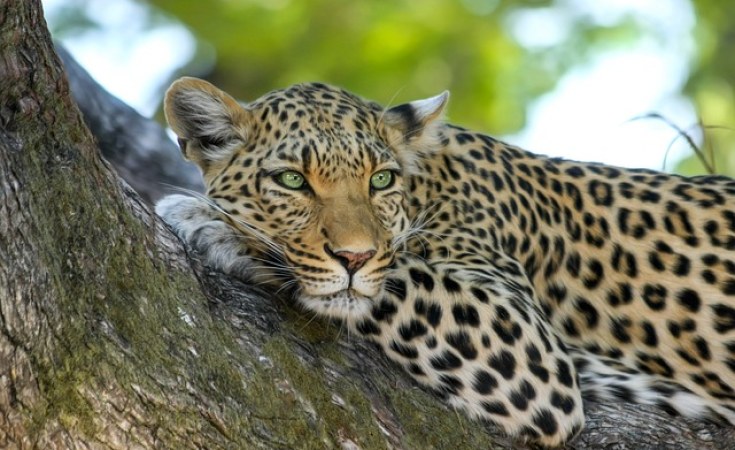An ice age almost one million years ago led to a meeting between leopards from central and southern Africa that were searching for grassland. New research into the leopards' genetics - their mitogenome - has revealed that the descendants of these two groups are the leopards found today in South Africa's Mpumalanga province. One of the researchers, molecular ecologist Laura Tensen, has been studying the genetic structure of South African leopards for 14 years. She explains how the new research can be used to help conserve the endangered big cats.
What is a mitogenome?
DNA is found in the nucleus of cells and also in the mitochondrial genome, or mitogenome. Mitogenomes are DNA molecules that float around outside the nucleus of a cell. They store their own set of genetic information and are maternally inherited, which means they are only passed on from mother to offspring.
Mitogenomes are a "genomic by-catch" when sequencing the whole genome. They are so abundant in cells that it is very easy to extract them.
Studying mitogenomes is a reliable way to track the ancestry of a species. This is because genes mutate (change) at a regular rate over time. The changes in the mitogenome provide a picture of leopard evolution over hundreds of thousands of years.
How do you test a leopard's mitogenome?
We took tissue samples from nine leopards in Mpumalanga, South Africa that had been knocked down by cars and killed. This unfortunately still occurs a lot. In non-protected areas, road kills account for all accidental mortality of leopards.
The samples were taken to the University of Johannesburg Wildlife Genomics laboratory and stored at -20°C before DNA extraction.
To retrieve the mitogenome, we sequenced the whole nuclear genome. When scientists sequence a whole nuclear genome, it allows them to discover the DNA sequence of every gene in an organism's genome at once. This then allows us to figure out what these genes exactly code for. For example, in red leopards, we have found the gene and mutation that causes the colour red. We've also been able to determine which inherited genes may cause health defects in the red leopard. We could use the same technique to find genes that make the two clades (groups of related leopards) unique, or better adapted to local environments.
After extracting the mitogenomes from the data, we assembled them and aligned them to a reference genome - one that has the exact positions of all the genes already. The reference genome was one that was previously sequenced and stored in an online database, Genbank, which is the collection of all publicly available DNA sequences.
We then downloaded lots of other mitogenomes from online databases, provided by previous studies, to compare our samples from South Africa to the rest of the continent.
In doing this, we were able to discover how mutations that arose over time were sorted over geographical space. Some of the samples were from natural history museums, collected up to 150 years ago. They represented the genetic structure of leopards before their habitats were broken up by humans.
What did you find?
We found that the South African leopards originated from two unique clades (or sub-families) that were found in southern and central Africa approximately 0.8 million years ago. It is likely that these clades originated during the Mid-Pleistocene, a period between 1.6 million and 0.52 million years ago when the world experienced an unstable climate.
We were able to establish this by measuring the evolutionary timeline, that is, the dates when the leopard species diverged against existing Eurasian leopard genomes, as well as lion and tiger genomes. Earlier research had already shown when these animals diverged from each other.
In sub-Saharan Africa, the Pleistocene, often referred to as the Ice Age, was marked by cool and dry cycles alternating with warm and wet climates. This drastically changed the landscape across the African continent, leading to repeated expansions and contractions of savanna grasslands.
Read more: We studied the DNA of African and Asian leopards and found big differences between the two
As a result, animals like leopards were forced to move around, looking for grasslands where their prey would be found. During dry periods, animal populations became isolated from each other as deserts took over the grasslands, becoming a barrier that kept leopards apart.
Once the leopard populations became separated, their genes started to differentiate over time.
The same kind of leopard movements still happen in South Africa today. Mainly young males can walk up to 300 kilometres away from their homes, looking for new territory. When they find it, they mix with leopards from other parts of Africa. It doesn't take many leopards to diversify the genes of a population. Eventually, the populations connect over time and space.
Why this matters
This is the first time that the leopard mitogenomes from South Africa have been put together. It allowed us to properly classify these leopards for the first time. This is useful because it can help with further research into how leopards evolved. Knowing how a modern leopard population is related to ancient populations, and the geographical paths they may have taken to reach this point, helps with conservation efforts.
In conservation today, leopards often have to be moved away (translocated) to avoid conflict with humans in areas where the cats might come into contact with livestock and eat them. It is important to know which animals are genetically diverse so that we can maintain this diversity across large areas. When animals are genetically diverse, they have more chance of surviving disease outbreaks.
One of the most important aspects of our study was discovering that although the leopard clades may have evolved separately, they are part of the same, interconnected metapopulation that stretches across southern Africa, and can be conserved in the same way.
Laura Tensen, Post-doctoral Fellow, University of Copenhagen


